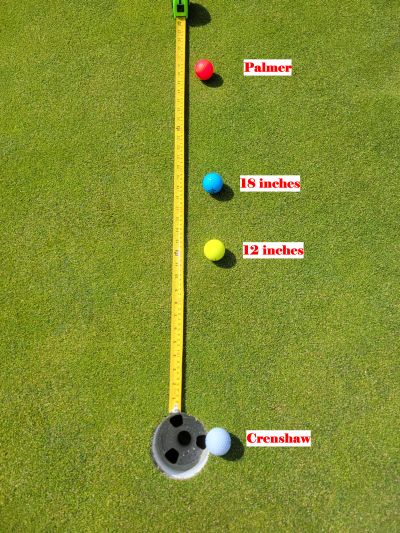March 28, 2022
What Kind of Putter are You? Part 3
 Distance control is probably the hardest ingredient that a golfer must master in becoming a good putter. Controlling the speed (I will use distance control and speed control interchangeably) determines the amount of break on a given putt. Tiger Woods, when he has putted exceptionally well, first gives credit to getting the speed correct. If that's right, everything else will fall into place.
Distance control is probably the hardest ingredient that a golfer must master in becoming a good putter. Controlling the speed (I will use distance control and speed control interchangeably) determines the amount of break on a given putt. Tiger Woods, when he has putted exceptionally well, first gives credit to getting the speed correct. If that's right, everything else will fall into place.
Dave Stockton, who is the best putter that I have ever played with, has stated that it is not his beautifully precise putting stroke that made him one of the best putters of all-time, but his ability to properly read greens and match what he saw to the correct speed. Dow Finsterwald, the 1958 PGA Champion, Ryder Cup captain and thirteen time winner on the PGA Tour, prior to his round before a tournament would not putt to holes, but to edges of the green or spots on the green to figure out how the greens were rolling that day. Tiger Woods, when practicing, would put a chalk line perpendicular out about 15 to 20 feet from his starting point and work for hours on getting his ball to stop on top of the line. If these great putters concentrated that much on distance and speed control, then the average player should follow their example and spend a great time on this area of their game.
The modern best putters use their arms and shoulders to stroke their putts. There are exceptions, but the most consistent leave the hands out of the stroke. The hands are there to give feel and feedback, but not to supply power. Generally, you want to take the putter back as far has you need to effortlessly transition the club back to ball. The follow-through should be either the same length as the backswing or shorter in length.
Exercise One: Pick a couple of holes that are between 20 and 30 feet apart. Putt three balls to the first hole and then back to the second. Now ONLY concentrate on rolling it by the cup by 12 inches. Do not center you attention on direction. See if you can have all three balls end the same distance by the cup.
Exercise Two: Putting is an art form. There is precision, but it does not have to be perfect. Again from 20 to 30 feet, putt with one hand and try to do it as naturally as possible. Only focus on getting the ball to go the right distance.
Exercise Three: My favorite. Again pick a 20 to 30 foot putt and hit your putt with your eyes closed! Then, before you open your eyes, guess where the ball ended up. This is hard, but surprisingly in time, you will start feeling the difference and you will become more accurate in your assessment. After you try the eyes closed method, you can then do the same drill with your eyes open, but don't look where the ball went and make a calculation before looking at the result. This ultimately will be your main drill when practicing your putting.
Are you a "Die it in the hole" Ben Crenshaw putter, or a "12 to 18 inches" past the hole type putter that Dave Stockton recommends, or a "charge it in the hole" style putter like Arnold Palmer was in his prime. All will work and it is up to you to determine what works best for you on your greens and situation.
BUT once you become more accomplished with stroke, speed, distance, and green reading, you then must adopt that I have witnessed in EVERY great putter that I have known. CONFIDENCE! I have known Dave Stockton since junior golf and college. He is one of the most positive individuals that I have ever met. It is not a cocky arrogant attitude, but he believes in what he is doing. He comes across as a positive person that you can't help but liking. Jack Nicklaus, also a very positive individual and great putter, was talking recently about Arnold Palmer. Jack thought Arnold as a great putter, especially through the 50's and 60's. His reasoning was that Palmer thought he could make any putt and aggressively attacked every putt. His confidence was so strong that he wasn't afraid of any putt and he thought he should make everything. I was around in the 60's and I watched his magic. His stroke wasn't the best, but his resolve and fortitude couldn't be beaten. You don't win 65 times on the PGA Tour with seven major championships without being a great putter. I believe his edge was his undying belief that he was going to make everything. He didn't make everything, but he certainly made a lot.
The last ingredient for a great putter: a Confident Attitude. I haven't seen a great putter that didn't have this quality. Think you can, see you can, believe you can and you will!!



